List of oldest heraldry
| Part of a series on |
| Heraldic achievement |
|---|
| External devices in addition to the central coat of arms |
|
|
This list of oldest heraldry aims to include the oldest documented, non-attributed heraldic achievements for individuals, families, locations or institutions.
Heraldry developed in the High Middle Ages (c. 1000-1250), based on earlier, "pre-heraldic" or "ante-heraldic", traditions of visual identification by means of seals, field signs, emblems used on coins, etc. Notably, lions that would subsequently appear in 12th-century coats of arms of European nobility have pre-figurations in the animal style of ancient art (specifically the style of Scythian art as it developed from c. the 7th century BC).[1]
The origin of the term heraldry itself (Middle English heraldy, Old French hiraudie), can be placed in the context of the early forms of the knightly tournaments in the 12th century. Combatants wore full armour, and identified themselves by wearing their emblems on their shields. A herald (Old French heraut, from a Frankish *hariwald "commander of an army") was an officer who would announce the competitors. The display of heraldic emblems on shields is an innovation of the 12th century. The kite shields shown in the Bayeux Tapestry (c. 1070) sometimes show simple cross or spiral ornaments, but no heraldic emblems. Similarly, Frankish or German round shields of the 11th century (Ottonian, Salian) are sometimes depicted with simple geometric ornamentation, but not with figurative emblems.[2] Early mention of heraldic shields in Middle High German literature likewise dates to the 12th century.[3]
In some cases, the adoption of a symbol on a coat of arms was the culmination of a gradual progression, whereby a family can be seen using a symbol in a quasi-heraldic manner prior to its adoption as part of a formal coat. An example of this are the Counts of Saint-Pol, who between 1083 and 1130 decorated their coins with wheat sheafs that are then found on the equestrian seal of Count Engueraud (1141-50) placed in the blank space surrounding the mounted knight, before appearing on the shield of count Anselm and his successors from 1162. Similarly, the fleur-de-lis progressed from use as a decorative emblem by Henry I of France (1031-60) to then be displayed as a quasi-heraldic symbol by Louis VI, Louis VII, and Philip II (1180-1223) before becoming the charge of the French royal arms under the last of these kings.[4] Lions were used as heraldic emblems by Henry "the Lion" (before 1146), and Alfonso VII of León (d. 1157),[5] and probably by Henry I of England (d. 1135),[6] in the first half of the 12th century, and lions later appear on the coats of arms of their respective realms.
The oldest surviving heraldic seals are the equestrian seals (German: Reitersiegel) used by high nobility in the second half of the 12th century. Among the oldest examples from the Holy Roman Empire, of what would develop into German heraldry, is the lion (or "leopard") of the Staufer coat of arms, first used before 1146 by Henry "the Lion", and in 1181 on the seal of Frederick VI of Swabia.[7] Similar seals are known from England, one of the oldest being the equestrian seal of King Richard Lionheart of the House of Plantagenet, dated 1189, showing a heraldic lion design on the king's shield. His second seal, dated 1198, shows the three lions design which would subsequently become the royal coat of arms of England.
The earliest known colored heraldic representation appears on the funerary enamel of Geoffrey of Anjou (d. 1151), showing a coat of arms that appears to be the same as one later used by some of his descendants. Depiction of heraldic shields in manuscript miniatures becomes more common in the early-to-mid 13th century, and dedicated armorials become fashionable in the mid-to-late 13th century.
List of oldest heraldry
| Year | Contemporary | Modern | Type | Armiger/attribution | Notes |
|---|---|---|---|---|---|
| 1138 | 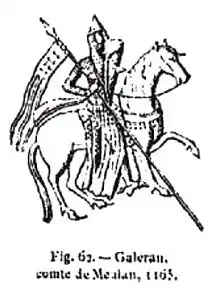 |
_arms.svg.png.webp) |
Family coat of arms | Waleran de Beaumont, 1st Earl of Worcester | These chequy arms appear on what is seemingly the earliest armorial seal in England or Normandy, though the first undated seal of his uncle Ralph I, Count of Vermandois, bearing a chequy livery may be older, having been replaced by the count's second seal in 1146. The tinctures of Worcester's coat were apparently the red and gold borne by his descendants, though the families of his full brother and of two half-siblings would instead bear variations of a blue and gold chequy shield.[8] |
| 1146 | Personal coat of arms | Henry the Lion | Among the oldest equestrial seals preserved are those of Henry the Lion of the House of Welf, duke of Saxony (1142–1180) and Bavaria (1156–1180). A total of seven seals of Henry's are known. Of these, only the second shows a recognizable lion displayed on his shield. This seal is attached to two documents dated to 1146. It is possible that the lion was also on the first seal (c. 1142), but it is no longer recognizable.[9]
An equestrian seal of similar antiquity is that of Ottokar III of Styria, dated 1160, with an early form of the Styrian panther on his shield. | ||
| by 1146 | 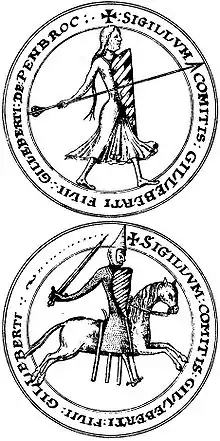 |
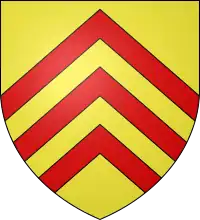 |
Family coat of arms | Gilbert de Clare, 1st Earl of Pembroke, Gilbert de Clare, 1st Earl of Hertford |
The seals of this uncle and nephew show variants of a common de Clare motif, with Pembroke using a chevrony coat also used by Hereford's sister, while Hereford's seal displays a simplified coat with three chevrons that would be used by Pembroke's son and the later Hereford earls. The charters to which the seals are attached are undated, but placed contextually no later than 1146.[10] |
| 1155-1160 | 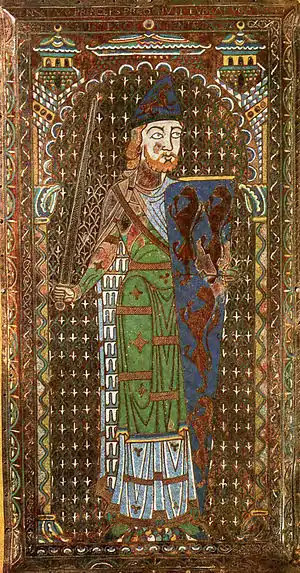 |
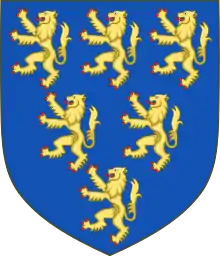 |
Personal coat of arms | Geoffrey Plantagenet, Count of Anjou | Appearing on funerary enamel commissioned by Geoffrey's widow Mathilda of England between 1155 and 1160 for his tomb (Le Mans Cathedral). The enamel shows four lions on the visible half of the shield, but is generally accepted as representing the same six-lion coat depicted on his grandson William Longespee's tomb effigy and known to have had the same tinctures. A late-12th-century chronicler wrote that in 1128, King Henry I presented to Geoffrey a badge of a gold lion.[11] |
| 1181 | 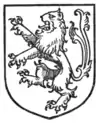 |
Personal coat of arms | Frederick VI, Duke of Swabia | Frederick VI is known to have displayed a lion rampant from 1181. His Reitersiegel, dated 1188 (original lost in 1847), shows his shield as displaying two lions rampant.
Frederick's younger brother Philip of Swabia (r. 1196–1208) used three lions, seen on a seal dated 1197. The three lions passant are later (after 1220) used as the family coat of arms of the Staufer, and still later as the coat of arms of Swabia.[12] | |
| 1187 | 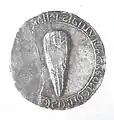 |
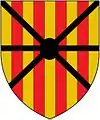 |
Personal coat of arms | Ramon Berenguer IV, Count of Barcelona | A pattern of red and gold striping is seen in the decoration of the tomb of countess Ermesinde in the mid-11th century (whether the colouring is original is disputed), and the same motif would be adopted for the arms of the County of Barcelona and Kingdom of Aragon. (es:Segell de Millau) |
| 1189 | 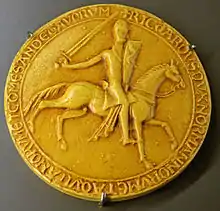 |
.svg.png.webp) |
Personal coat of arms | King Richard the Lionheart | The first documented royal coat of arms of England. With only half of the shield visible, it is unclear if the unseen half had a second lion or if only the visible lion was present, and if the latter, whether the direction the lion faced was relevant or simply reflected artistic licence. Colours are unknown, but several close kin of his father used arms with one or more gold lions on a red background, so these were perhaps the tinctures of this shield. |
| 1190s | 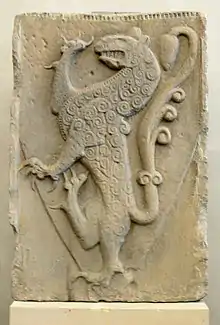 |
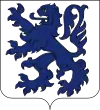 |
Family coat of arms | Welf VI, Welf VII | Heraldic lion in sandstone at Steingaden Abbey, presumably as funerary monument for Welf VI (d. 1191) and Welf VII (d. 1167), known as the oldest heraldic monument in Germany. The original monument consists of the lion on its own, the escutcheon outline was added in the later 13th century. The lion was originally colored blue. |
| c. 1194 |  |
 |
Personal coat of arms | Canute VI of Denmark | The seal of Canute VI, dated c. 1194, shows an early form of what would become the family coat of arms of the House of Estridsen, and in modern times the coat of arms of Denmark.[13] |
| 1198 | 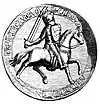 |
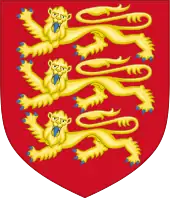 |
Personal coat of arms | King Richard the Lionheart | Richard's 2nd Great Seal of the Realm (reverse) (several surviving exemplars in England and France). The colours are unknown, but likely matched the coat used by his successors, with three gold lions on red, which remain the arms of England. |
| 12th c. ? | .jpg.webp) |
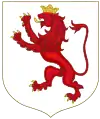 |
Personal coat of arms | Alfonso VII of León, Castile and Galicia | The adoption of the lion as personal emblem by King Alfonso VII (1126-1157) is ascertained based on the contemporary Chronica Adefonsi imperatoris.[5] An actual depiction of the emblem is not preserved from the epoch, the oldest representation of the Shield of León are illuminations in the "Tumbo A" manuscript, a cartulary of Santiago de Compostela Cathedral that includes material from the 12th to the mid-13th centuries.[14] Shown here is a detail of a miniature of Alfonso IX (r. 1188-1230). It is uncertain under which king the lion emblem of Alfonso VII was placed on the royal coat of arms, nor is it known whether the representations in the Tumbo A are contemporary with the monarchs illustrated or represent later attributed arms. |
| c. 1230 | 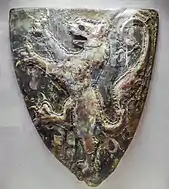 |
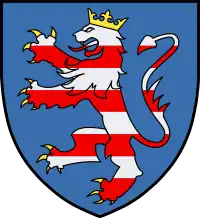 |
Knightly shield | Conrad of Thuringia | The depiction of heraldic designs on actual cavalry shields (knightly shields), the historical origin of the escutcheon, no doubt date to their depiction on seals in the 12th century. However, this artefact type is very rarely preserved, and the oldest extant examples date to the first half of the 13th century. An early example is the shield of Conrad of Thuringia (c. 1230), showing the Ludovingianlion barry (later the coat of arms of Hessen and Thuringia). |
| 1237 | 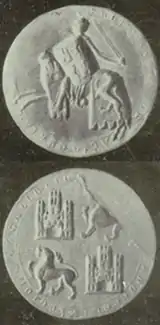 |
.svg.png.webp) |
Personal coat of arms | Ferdinand III of Castile | In earliest known quartered arms, Ferdinand III represented the union of his father's kingdom of León with his mother's Castile by placing the symbols of both on a quartered shield, appearing on his seal. |
| c. 1260 | Burgher arms (Italian republics) | (Siena, Florence) | Italian merchants and bankers first adopt heraldic emblems in the mid 13th-century.[15] | ||
| 1294 | 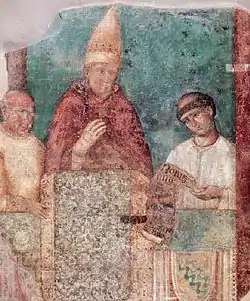 |
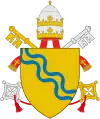 |
"Papal" coat of arms | Pope Boniface VIII | Popes of the late medieval and early modern period used their family coats of arms (the earliest exception being Nicholas V, r. 1447–1455). The coat of arms of Boniface VIII (r. 1294–1303), an early form of the Caetani coat of arms, happens to be the first coat of arms used by a pope preserved in a contemporary depiction. |
| 1290s | 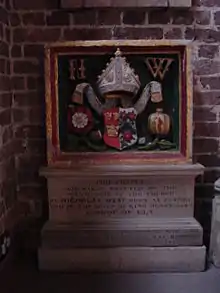 |
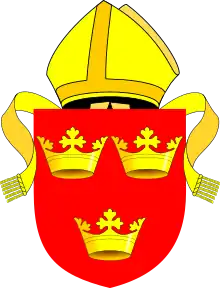 |
Ecclesiastical heraldry |
Diocese of Ely | Possibly the earliest documented coat of arms for a diocese.[17] |
| 1315 | .svg.png.webp) |
Civic heraldry | Brno, Moravia, Czech Republic | The seal from 1315 shows show four bars, red and silver. | |
| c. 1340 | 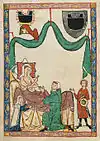 |
Burgher arms (Holy Roman Empire) | (various) | The earliest coats of arms taken by non-nobles, mostly families of the patriciate of imperial cities (Bürgerwappen), but also free farmers (Bauernwappen), appear in the 14th century. An early example of coats of arms attributed to commoners are found in Codex Manesse, "masters" (Meister, a title given to commoners) Heinrich Frauenlob and Heinrich Teschler (shown here is Teschler's coat of arms from Codex Manesse. The name Teschler translates to "bag maker", and the coat of arms shows argent a bag sable). | |
| 1369 | 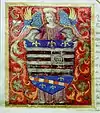 |
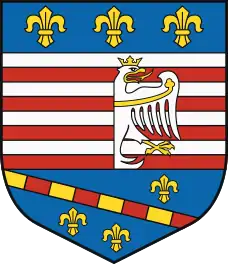 |
Civic heraldry | Košice, Slovakia | Claimant to be the oldest coat of arms of a town, granted by Louis I of Hungary, |
| 1441 | 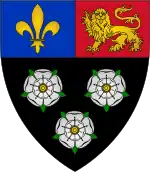 |
Academic heraldry | King's College (Cambridge) | Possibly earliest documented coat of arms for an academic institution, at least in England, granted by Henry VI. |
See also
| Wikimedia Commons has media related to Shields in early heraldry. |
References
- "significant pre-figuration of medieval heraldry" John Onians, Atlas of World Art (2004), p. 58.
- Round Shield Designs (vikingage.org): "chequered" (11th c., Biblio. Mun. Avranches MS50), "flared cross" (c.1000-1050 Arras, BM MS 559 (435), vol. 1), "spirals" (c.1000-1050 Arras, BM MS 559 (435), vol. 1), "spirals with dots" (c.1000-1020 Bamberg MS A. II. 42 Bamberg Apocalypse).
- "With the exception of several heraldic shields that appear in the Kaiserchronik [c. 1150–1170], such as the boar carried by the Romans—the oldest heraldic insignia in medieval German epic literature, according to Zips [Wappenwesen, 1966]—most of the precourtly and even courtly epics up to 1200 contain very few decorated shields at all. Several isolated coats of arms are mentioned in the German Rolandslied [c. 1115], König Rother [c. 1150], Veldecke's Eneas [c. 1170], and Hartmann's Erec [c. 1185]—mostly related to the protagonists." Haiko Wandhoff, "The Shield as a Poetic Screen: Early Blazon and the Visualization of Medieval German Literature" in: K. Starkey (ed.), Visual Culture and the German Middle Ages (2016), 53–72 (p. 57).
- Ailes, Adrian, The Origins of The Royal Arms of England: Their Development to 1199, Reading Medieval Studies Monograph No. 1, Reading University, 1982, pp. 25-6
- Riquer, Martín de (1942) Manual de heráldica española. Barcelona: Apolo.
- Ailes, pp. 46-47
- Werner Hechberger, Staufer und Welfen 1125-1190: zur Verwendung von Theorien in der Geschichtswissenschaft (1996), 1996 p. 342; Xenja von Ertzdorff, Rudolf Schulz, Winfried Baumann, Die Romane von dem Ritter mit dem Löwen (1994), p. 174.
- White, Geoffrey (1953). "Appendix J: The Warenne group of chequered shields". The Complete Peerage, or a history of the House of Lords and all its members from the earliest times, volume XII part 1 (2nd ed.). London: The St. Catherine Press. pp. appendix, 26–29.
- Xenja von Ertzdorff, Rudolf Schulz, Winfried Baumann, Die Romane von dem Ritter mit dem Löwen (1994), p. 175, citing Schmidt-Phiseldeck, Die Siegel des herzoglichen Hauses Braunschweig und Lüneburg, nr. 1–4.
- J. H. Round, "The Introduction of Armorial Bearings into England", The Archaeological Journal, volume 51, pp 43-48
- Wagner, A. (1946). Heraldry in England
- Peter Koblank, Stauferwappen (2016).
- Bartholdy, Nils G. (1995). Denmark's Arms and Crown (in Danish). Copenhagen: Ministry of Culture. p. 16. ISBN 87-87361-20-5. Retrieved 26 May 2017.
- Chao Prieto, Ricardo: La Bandera Medieval del Reino de León [The medieval banner of the Kingdom of León]. Banderas, No. 98, Spanish Society of Vexillology. Retrieved 14 August 2018.
- "The thirteenth century also witnessed the adoption of armorial devices by some at least of the merchants. In 1263 the arms of the 'Four Provisors' of the Biccherna at Siena were painted on the cover of the tax-book for that year inaugurating that well known and valuable series. At Florence in the same year Raynuttio Ardengi, a merchant of that city, sealed with a shield Barry of eight set between the attires of a stag's head." John A Goodall, "Heraldry in Italy during the Middle Ages and Renaissance", Coat of Arms 37 (January 1959).
- "We have seen that Pope Clement IV granted his own arms to the Guelfs of Florence, but the first Pope for whom there is contemporary evidence for th arms actually used by him is Boniface VIII after about 1295. A tablet recording the foundation of an oratory by Tommaso Andrei Bishop of Pistoia in 1296 has two small shields of his arms a Rose or cinquefoil between three roundels. After 1300 the evidence for the use of arms by ecclesiastics of all ranks becomes more frequent and there can be little doubt but that the late date of their adoption when compared with France or Germany is due to the conservative influence of the Roman Curia." John A Goodall, "Heraldry in Italy during the Middle Ages and Renaissance", Coat of Arms 37 (January 1959).
- Briggs, C. (1970). Civic and Corporate Heraldry
- Gerard J. Brault. Early Blazon. Heraldic terminology in the twelfth and thirteenth centuries, with special reference to Arthurian literature. Oxford, Oxford University Press, 1972.